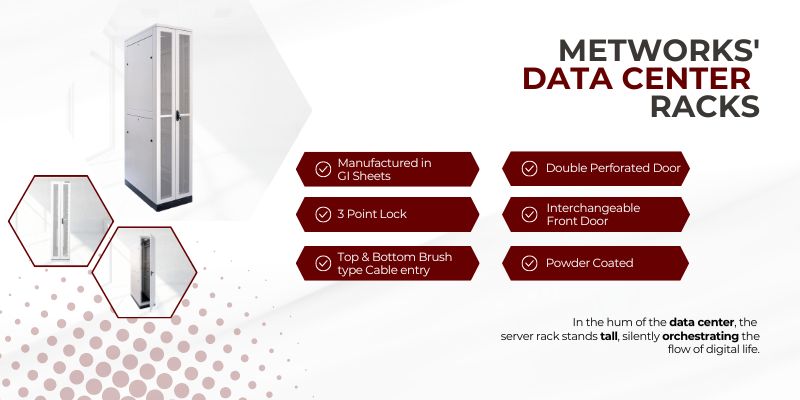As organizations increasingly rely on data centers to manage vast amounts of information, optimizing cooling efficiency has become a critical focus. The design and layout of data center racks play a significant role in how effectively cooling strategies are implemented. A well-thought-out rack design not only enhances thermal management but also contributes to energy savings and operational efficiency. This article explores the relationship between data center rack design and cooling efficiency, providing insights into best practices for optimizing thermal management.
Understanding the Importance of Cooling in Data Centers
Cooling in data centers is essential for maintaining the optimal operating temperature of servers and other IT equipment. Excessive heat can lead to hardware failures, reduced performance, and increased downtime, significantly impacting business operations. According to the U.S. Department of Energy, data centers consume about 2% of the country’s total electricity, and a significant portion of this energy is used for cooling. Therefore, effective cooling strategies can lead to considerable cost savings and improved equipment longevity.
Factors Influencing Cooling Efficiency in Data Center Rack Design
1. Rack Configuration
The configuration of data center racks significantly impacts airflow patterns and cooling effectiveness. Common configurations include:
- Open Frame Racks: These racks facilitate unobstructed airflow, making them ideal for environments where cooling is a primary concern. However, they may require additional considerations for equipment security and cable management.
- Enclosed Racks: These racks provide better security and protection from dust and contaminants. They can also be designed with features like side panels and doors to optimize airflow. However, careful attention must be paid to ensure that airflow isn’t restricted, which can lead to hot spots.
2. Hot Aisle/Cold Aisle Containment
Implementing a hot aisle/cold aisle configuration is one of the most effective strategies for enhancing cooling efficiency. In this setup, racks are arranged in alternating rows, with cold air intakes facing one aisle and hot air exhausts facing the opposite aisle. This arrangement helps to maintain a clear separation between hot and cold air, reducing the mixing of air and allowing cooling systems to work more efficiently.
Containment Solutions: To further enhance this strategy, data centers can utilize hot aisle containment or cold aisle containment systems.
- Cold Aisle Containment: Encloses the cold aisle, trapping cold air and preventing it from mixing with the hot air exhausted by the servers.
- Hot Aisle Containment: Encloses the hot aisle, directing hot air back to the cooling units, thereby improving the efficiency of the cooling system.
Both methods improve cooling performance and energy efficiency by ensuring that cooling units can operate effectively without working against mixed airflow.
Suggested Read: The Evolution of Server Racks: From Basic Structures to Smart Solutions
3. Rack Density
The density of equipment within the racks also influences cooling efficiency. Higher density racks, often referred to as high-density racks, house more equipment in a smaller footprint, which can create challenges for cooling. When too many servers are packed into a small area, the heat generated can exceed the cooling capacity of the system, leading to overheating.
Balancing Rack Density: It’s essential to balance rack density with cooling capabilities. This can involve:
- Distributing high-density loads across multiple racks to prevent localized hotspots.
- Utilizing intelligent cooling solutions, such as variable speed fans or cooling units that adjust based on real-time temperature readings.
4. Airflow Management
Effective airflow management is critical to cooling efficiency. This includes:
- Cable Management: Properly managing cables can prevent airflow obstructions, ensuring that cool air can circulate freely around the equipment. Using cable trays, ties, and pathways to keep cables organized is essential.
- Sealing Gaps: Identifying and sealing gaps around racks can prevent the bypass of cooling air, allowing for more efficient cooling. This includes sealing any unused rack space with blanking panels to direct airflow effectively.
- Using Fans and Blowers: Supplemental cooling solutions, such as fans and blowers, can be deployed to improve airflow in high-density areas or to direct cool air to specific equipment.
5. Temperature Monitoring and Control
Implementing temperature monitoring systems can greatly enhance the effectiveness of cooling strategies. Data center managers can use sensors to monitor the temperature at various points within the rack and make adjustments as necessary. Automated systems can help regulate cooling units based on real-time temperature data, ensuring that the cooling system operates efficiently without excessive energy use.
Conclusion
The design and layout of data center rack significantly impact cooling efficiency and overall thermal management. By understanding the factors influencing cooling—such as rack configuration, aisle containment strategies, rack density, airflow management, and temperature monitoring—data center managers can implement effective solutions to optimize performance. Investing in thoughtful rack design and innovative cooling strategies not only improves energy efficiency but also enhances the reliability and longevity of IT equipment. As data centers continue to evolve, prioritizing cooling efficiency through strategic rack design will be essential for sustainable operations.


